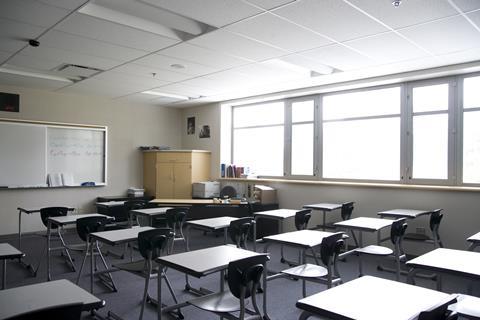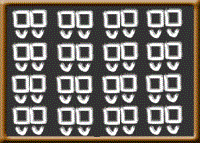Tim Bowen discusses the possible benefits of using a triangular classroom layout, along with other, more traditional options.

Introduction
An interesting article appeared in The Guardian some years ago, in which the use of a triangular classroom layout was described. It should be said at the outset that the classroom building described in the article is, itself, triangular, and that the formation inside it is based on rows of students. The front row contains the longest line, and then the lines gradually taper towards the back, ending with a single student in the back row.
Advantages cited are:
- a better view of all the students for the teacher,
- a better view of the board for the students,
- the ease with which the students can be regrouped,
- and the fact that for both staff and students it is something of a novelty.
What seating options are available to EFL teachers?
While it is unlikely that many EFL teachers are able to enjoy the potential benefits of a triangular classroom building, there is no reason why teachers cannot experiment with different seating formations in order to give their learners a different perspective. The most basic arrangement, that of having learners in rows, has its disadvantages, but even this formation can be productive, giving opportunities for pair work and being particularly suitable for writing activities.
In recent times, the horseshoe arrangement has found a lot of favour amongst teachers as it enables all the learners to see each other and provides a convenient forum for open pair activities, question and answer and mingling activities. The L-shaped arrangement provides similar advantages.
Teachers whose classes are engaged in a lot of small group work or writing activities (on examination preparation courses, for example), may prefer the arrangement of learners working in groups of four to six around separate tables. This also gives the teacher easy access to the learners in order to monitor their work.
The large 'solid' square, formed by placing tables together and having learners sit around the outside, also has its advantages. It can create a 'workshop' atmosphere and also enables learners to see each other fairly easily.
One class observed by the writer of this article had an interesting formation devised by the teacher – on a cold December evening, instead of sitting in a horseshoe facing the board, the learners sat in a horseshoe facing the fire (a simulated coal-fire!), while the teacher told a ghost story. The arrangement was entirely appropriate and made a significant contribution to the success of the lesson!
Is the triangular layout a practical option?
But what of the triangular classroom for English language classes? This, too, could have considerable advantages. An 'open' triangular formation (with or without desks) would enable all the learners to see each other reasonably well. It would also give the teacher flexibility in his or her position in the class. It might also have the positive effect of being something of a novelty and therefore a motivational factor. As for the 'closed' triangular formation, the advantages are outlined at the beginning of this article.
Conclusion
Whatever the advantages and disadvantages of a particular formation, it is certainly worth experimenting with different ones from time to time. At the very least it will give you and your learners a different point of view – literally!
Credits
Classroom management
- 1
- 2
- 3
- 4
- 5
- 6
- 7
- 8
- 9
- 10Currently reading
Classroom management: The triangular classroom
- 11
- 12












No comments yet